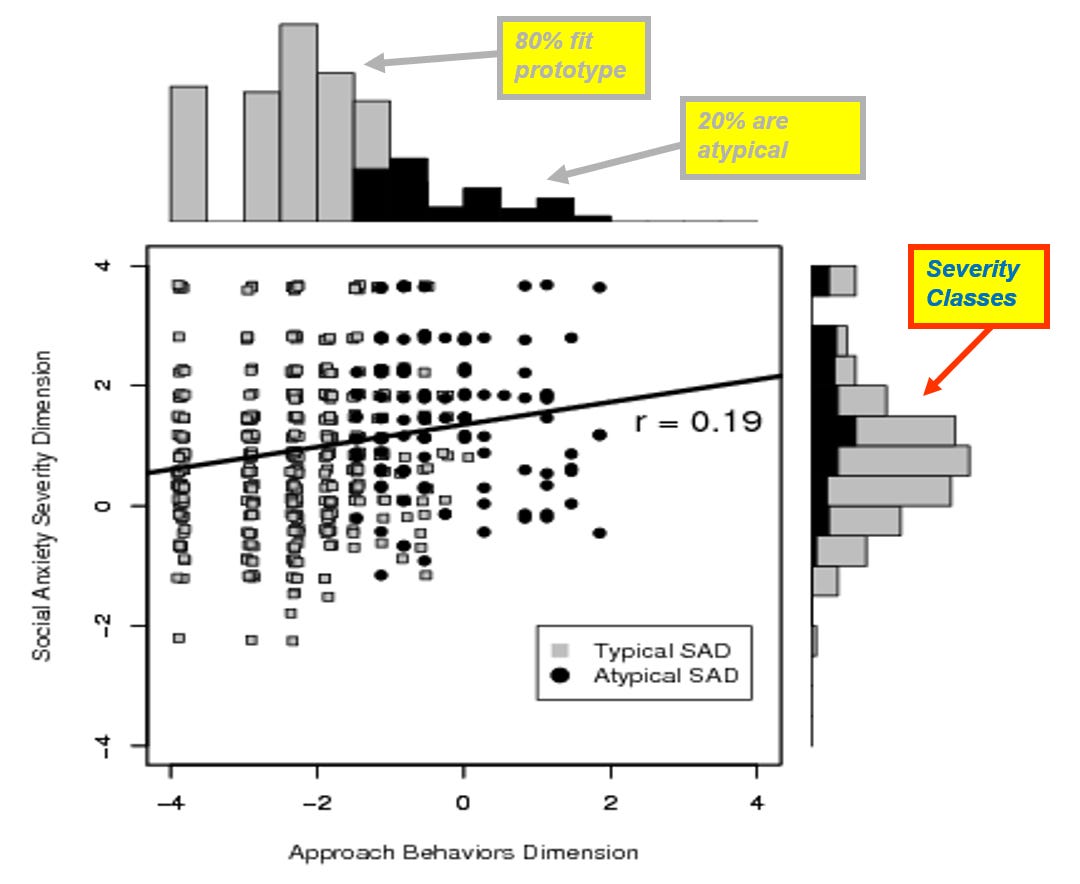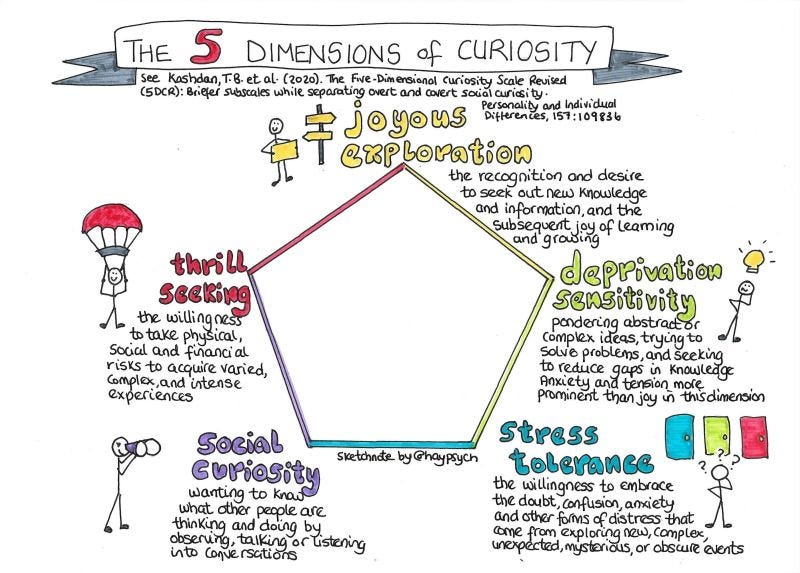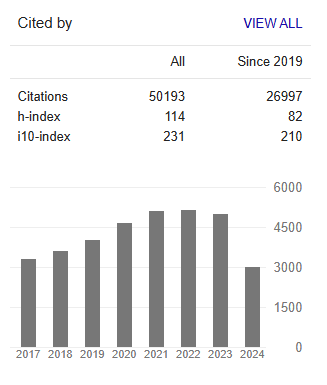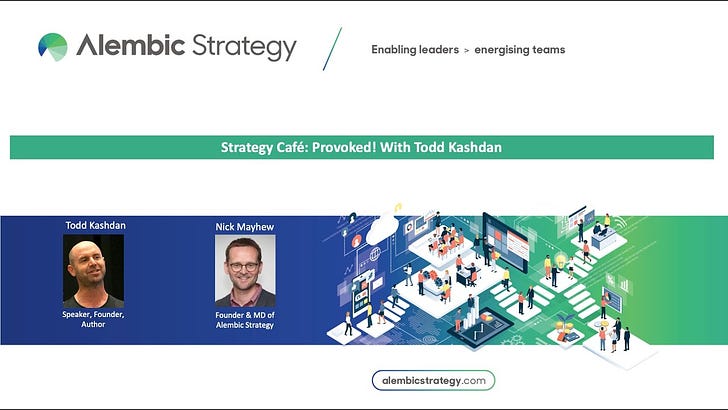50,000 Citations Celebration! My 3 Favorite Well-Being Laboratory Discoveries
Misunderstandings About Social Anxiety, The Complexity of Curiosity, Precision on Purpose in Life
For this celebration, free or premium subscriber, I’m inviting you to comment on this article. Let’s see how it goes. I will stick to a “no asshole rule.” Assume positive intentions until proven otherwise. Disagree all you want, but keep it about the ideas, not the person. Let’s reduce the needless hate and spite online. Now on to the party…
When I wrapped up graduate school in 2004, I couldn't have imagined over 50,000 citations to my research! The goal of science is to influence the thoughts of fellow researchers, practitioners, and public policy; with hopes to enlighten the public. This should be incentivized much more than quantity of output. Here’s a snapshot of the number (from Google Scholar) that allows me to reflect on 25 years of psychological research.
With this milestone, let me share my three favorite research findings from The Well-Being Laboratory (founded in 2004).
3. Social Anxiety is Misunderstood
When we hear "social anxiety," we often picture shyness, submissiveness, and risk avoidance. However, a significant segment—about 20%—defies this stereotype. These individuals display heightened reward-seeking behaviors, impulsiveness, and risk-taking, engaging in activities like excessive partying, aggression, and substance use. This isn't just an isolated finding; it's been replicated by other research teams (here). The traditional approach to treating social anxiety might be missing the mark for this unexpected subgroup. Understanding this complexity is crucial for effective prevention efforts.
Kashdan, T. B., McKnight, P. E., Richey, J. A., & Hofmann, S. G. (2009). When social anxiety disorder co-exists with risk-prone, approach behavior: Investigating a neglected, meaningful subset of people in the National Comorbidity Survey-Replication. Behaviour Research and Therapy, 47(7), 559-568.

We offer five compelling explanations for this atypical subgroup. Read them on p. 565. Hopefully somebody will test them…
2. People Possess Curiosity Profiles
To this day, people still talk about curiosity as a single dimension - from low to high. But this never matched the scientific literature, which suggested different types of curiosity. Upon synthesizing much of what is known, we tested a multi-dimensional profile approach to curiosity. In an initial series of studies (here), a set of refinements (here), an extension to the workplace (here), and a replication in nine countries (here), we continue to find evidence for five curiosity dimensions. Other researchers continue to independently replicate this model (here).
Collapse these dimensions and you will never understand how curiosity operates - as each dimension has different causes and consequences.

If you are interested in curiosity across the world, you might find theses graph interesting. The scores for our M-Workplace Curiosity Scale are similar across diverse countries [Joyous Exploration (JE), Deprivation Sensitivity (DS), Openness to Other People’s Ideas (OP), and Stress Tolerance (ST)]:


You might also be wondering, “How do men and women differ in these curiosity profiles?” Across nine countries, see for yourself.

If you are new to Provoked, know that I write about the science of curiosity a lot. Why? Because most articles, books, and talks are far too simplistic. Check out prior issues on how this strength changes over the lifespan (here), enhances creativity (here), alters social interactions (here), persuades people (here), how there are hidden costs (here), and how prior knowledge impacts curiosity in unusual ways (here).
1. Purpose Requires a Clear Definition and Model
Dr. Patrick McKnight and I are alarmed by the lack of clear definitions of purpose. Instead of merely voicing concerns, we took action. In 2009, we crafted a definition and conceptual model of purpose in life, drawing inspiration from luminaries like Viktor Frankl, Paul Wong (read my ode to him - here), Carol Ryff, and William Damon. The journey was arduous; the peer review process was grueling. Our initial submission to the American Psychologist was rejected—they deemed the use of Hitler as an example of maladaptive purpose as unacceptable (read the full story here). Undeterred, we refined our model and with immense satisfaction, saw it published in the American Psychologist in 2024. Our goal: we want researchers, practitioners, policymakers, and the public to possess language to discuss purpose.
Purpose is a central, self-organizing life aim that can be evaluated on the dimensions of strength (i.e., the influence it has on behavior), scope (i.e., the range of domains affected), and awareness (i.e., the degree to which there is conscious clarity and articulation; McKnight & Kashdan, 2009). A purpose is central such that the nature of these concerns and pursuits becomes a predominant theme of a person’s identity. A purpose is self-organizing in that it motivates a person to dedicate finite resources toward certain goals and away from others; it is easier to dedicate time, energy, attention, money, and social capital when there is hope that effort translates into purpose-related progress. A purpose is a life aim represented as a long-term commitment that is difficult to accomplish in a short period. For instance, a purpose might be to care for animals, which have no terminal end. A goal toward that purpose might be fulfilled by becoming a veterinarian, which has a clear stopping point after receipt of a degree and job. Effort expenditure toward a purpose can be viewed as striving toward reinforcing goals that are congruent with one’s deepest values (Emmons, 2003; Sheldon, 2004). Central, self-organizing, life-aim features define purpose.
Kashdan, T. B., Goodman, F. R., McKnight, P. E., Brown, B., & Rum, R. (2024). Purpose in life: A resolution on the definition, conceptual model, and optimal measurement. American Psychologist
If purpose in life truly holds the transformative power that Viktor Frankl, George Bernard Shaw, Helen Keller, Carl Jung, and George Eliot assert, then the scientific exploration of this concept must advance. We don't just present answers; we explore some of the mechanisms that reveal how purpose in life impacts health and well-being. Here are 10 pathways outlined in our 2009 article (notice path #10, the controversial one, suggesting that a small subset of people are unable to create and/or pursue a purpose):
This leads into my absolute favorite career finding. It begins with questions, “What happens when people suffering from social anxiety disorder devote significant effort to their self-defined purpose in life? Can purpose serve to reduce psychological difficulties?” Let me present it as I do in classes and workshops:
We found evidence for a naturalistic intervention. With nary a mention about anxiety, people with social anxiety disorder vary from one day-to-the-next on how much effort they dedicate to their purpose. On days when they show commitment to a purpose, they show a substantial improvement in their well-being (self-worth, sense of meaning, positive emotions, and (lower) negative emotions). Take this in - we are only discussing effort, not progress. So. Freaking. Cool! Read the full article here:
Gratitude
Upon reflecting on the 230+ scientific articles I've published, I'm struck by the presence of over 200 co-authors. Each name represents a vital contribution. I can't list them all here, but their impact is undeniable. My achievements are theirs too. When minds converge—two, three, six, even 10 —magic happens. But only if everyone commits, contributes, and an environment exists for them to voice their views. Our productive conflicts fuel research discoveries. Together, we create something far greater than any of us could alone. I wish every reader the amazing collaborators I have…
Thanks for reading Provoked. If you’d like to support my work please:
Leave a ❤️ so that others can find it;
Leave a comment (I’ll do my best to respond);
Share this post by email or on social media;
Start a paid subscription to this Substack (with benefits such as access to monthly virtual calls, premium chat room, and 200+ article archive). As an extension of the 50,000 citation celebration, Provoked Premium Subscribers will get access to important unpublished findings from The Well-Being Laboratory (which I cannot wait to share).
Todd B. Kashdan is an author of several books including The Upside of Your Dark Side (Penguin) and The Art of Insubordination: How to Dissent and Defy Effectively (Avery/Penguin) and Professor of Psychology and Leader of The Well-Being Laboratory at George Mason University.
Read Past Issues Here Including:
Avoiding, Accepting, and Harnessing Pain: Turning Stoicism into Scientific Tools and Strategies
Want to know the emotion that people are most afraid of? How to handle painful emotions? I did an amazing live interview with one of the most brilliant, underappreciated minds in the well-being space: Nick Mayhew.







As an actor in this multi-act play, I found your post delightfully uplifting. There is more to citations than just recognition. Many hours go into each paper and some do not enjoy the success as others but they remain our primary intellectual legacy. Tough task to highlight a few papers but I think you nailed it. I look forward to many more papers and citations in the years to come.
So awesome to have that metric to see. CONGRATULATIONS! Both on the accomplishment and you embracing celebrating it!
Wouldn't be fun if we could collect data on the influence your work has on a B2C level. Sorry old habits. The citations are like B2B influence. Could you imagine the number of humans running around using the constructs and insights you have contributed? That would be a cool visualization.